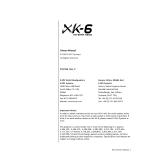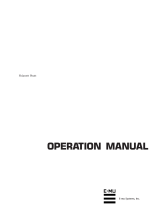Page is loading ...


The first step in synthesizing a sound, percussive
or otherwise, is understanding how to visualize
sonic information in terms of the control
parameters of your synthesizer.
Most synthesizers employ a 4-stage amplifier
envelope to control a sound’s volume over time.
These 4 “stages” are commonly labeled: ATTACK,
DECAY, SUSTAIN & RELEASE.
COMMON
VOLUME
ENVELOPES
HORNS
UN-MUTED
BASS DRUM
TIGHT SNARE
ADSR
amplitude
attack
decay
sustain
release
time
AT TACK : The amount of time it
takes a sound to rise from zero to
maximum when a key is depressed.
DE CAY: The amount of time it takes
a sound to descend from maximum
level to sustained level.
SU STAI N : The level at which a
sound remains while a key is held,
after the Decay stage is complete.
RELEASE: The amount of time it
takes for a sound to descend from
its sustained level to zero.
AMP. ENVELOPE
To synthesize a drum sound, begin by creat-
ing a percussive amplifier envelope. When
striking a drum head, the sound does not
“swell” in, nor does it continue to sustain if
you hold the stick against the head. With
this in mind, set the Attack and Sustain
parameters to their minimum position.
tight
boom
Percussive sounds are typically played by quickly
striking and releasing a medium, (think of finger
drumming on an MPC). With this in mind, use the
Amplifier Envelope's Release control to determine
how long or short a sound “rings out” after a note is
release. The Decay control will influence your Release
settings when Sustain is set to zero, so set Decay to
center position until you get a feel for it.
tight
boom
The First Step
Moog Music’s Guide To Analog
Synthesized Percussion
Creating tones for reproducing the
family of instruments in which sound
arises from the striking of materials
with sticks, hammers, or the hands.

Now that you have a percussive amplifier
envelope, you need a sound source. Kicks, snares,
toms, & cymbals can all be created using a similar
amplifier envelope with different harmonic
content. Synthesizers offer many tools with which
to create harmonic content including oscillators,
filters, noise generators and modulation.
Wave Shapes
These are a synthesizer’s
primary source of sound.
Oscillators create different
waveforms that can be used to
determine the complexity of
harmonic content before it is
sent through the filter section.
FILTER SECTION
SAW: Contains all
integer harmonics.
Use for warm, artic-
ulate percussion
TRIANGLE: Contains
exponentially descend-
ing odd harmonics. Use
with noise for pitched
tom drums.
SQUARE: Contains only
odd harmonics. Its
hollow sound is good for
low register kick drums.
FILTE R: The filter can be driven into self-oscillation by
setting it's Resonance control to maximum. At this point
the filter becomes a sine wave generator perfect for
creating massive 808-style kicks & toms. The Cutoff
parameter of a self-oscillating filter now controls its
frequency, while the KB AMOUNT knob determines how
the keyboard's pitch effects the Cutoff frequency.
DON’T FORGET: Experimentation & learning will reward
you with a lifetime of rich synthesizer experiences.
NOISE: Contains all
frequencies. Noise is
used to create snares,
and to add acoustic
qualities to synth
percussion.
self
oscillation
s
i
n
e
f
r
e
q
u
e
n
c
y
s
i
n
e
f
r
e
q
u
e
n
c
y
OscillatorsSound Source
Moog Music’s Guide To Analog
Synthesized Percussion
Creating tones for reproducing the
family of instruments in which sound
arises from the striking of materials
with sticks, hammers, or the hands.

MOD WHEEL must be up • LFO RANGE SELECTION set to high (Manual pg.28) • • FILTER SLOPE set to 1 Pole (Manual pg.28) • LFO GATE RESET set to ON (Manual pg.25)

Mod Wheel in up position

HI HAT
/
BLOCK
SPACE DRUM
Mod Wheel in up position
MOD WHEEL must be up • LFO RANGE SELECTION set to high (Manual pg.28) • • FILTER SLOPE set to 1 Pole (Manual pg.28) • MULTI TRIG set to ON (Editor)
/

